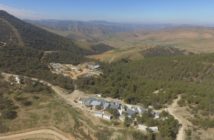An illustration of the a stout, short-bodied, four-legged animal with a short tail and short neck. Click to enlarge this image.
Frederik Spindler
THE GIST
- A sophisticated underground animal world existed 240 million years ago in Morocco.
- Tunnels, chambers and other structures related to the early burrows suggest they provided escape from predators and weather extremes.
- Stout, four-legged clawed animals likely built the Middle Triassic Era burrows, which pre-date dinosaurs.
Long before dinosaurs, something was digging intricate homes and roads underground.
While life on Earth 240 million years ago flourished in the seas and on land, the underground worlds discovered in Morocco are the oldest example of such communal subterranean structures from a low-latitude area.
The burrows, described in the latest issue of the journal Palaios, are the world’s second oldest known communal burrows. The oldest, from South Africa, only predate these by 5 million years.
NEWS: Pre-Dinosaur Predator Found With Fangs Intact
It’s possible that a similar animal created both structures.
“You should imagine the tracemaker as a stout, short-bodied, four-legged animal with a short tail and short neck,” lead author Sebastian Voigt told Discovery News. “The trunk was about 20-25 centimeters (8-10 inches) in length. We have to assume that it had five sturdy digits with claws suitable for digging into moderately soft sediment.”
Funded by the German Research Foundation, ichnologist Voigt from the Institute of Geology at TU Bergakademie Freiberg and his colleagues studied the burrows, located in red beds of the Argana Basin in central Morocco. The architecture consists of numerous openings, exists, tunnels and chambers.
“The Argana burrows do not have any equivalent in the fossil record or among extant burrowing vertebrates,” Voigt said. “Their chambers are exceptionally complex structures and two-fold winded tunnels have never been observed anywhere else.”
Based on this arrangement and what can be inferred about the burrow makers, the scientists think the underground world served as a retreat, permitting escape from predators. Although dinosaurs were not yet around, huge fast-running crocodiles with long legs were in the area, as evidenced by fossil finds. Close relatives of today’s lizards, snakes and tuataras were also around, along with relatives of birds and dinosaurs.
The site’s geology as well as the burrow’s design also suggests the animals headed underground to tolerate weather extremes.
NEWS: Pre-Dino Toothy Marine Animals Found
“During the Triassic, the region probably was a semiarid large inland basin,” Voigt explained. “Rivers were slowly flowing after episodic rain fall. Streambeds were flat and completely dry for lengthy periods. Loose vegetation covered the banks of the streams. It was hot during the day and cold in the night.”

The burrow system, as illustrated by the study authors.
The smooth floor of the tunnels reveals they were well used, with the animals probably gathering food, such as plants, roots and insects, at the surface during nighttime.
Burrows made by individual animals, such as fish, date to early Paleozoic periods, indicating this behavior was very important since practically the beginning of complex animal life on the planet. Voigt suspects it first evolved to permit escape from environmental extremes, particularly drought.
It seems that whenever animals could dig to escape, they did. Some dinosaurs dug burrows. One of the limitations is having the right substrate. In the case of the Moroccan animals, the conditions were perfect for digging. The burrows there were constructed in riverbank sandy substrates intermixed with moist overbank mud.
Molly Miller, a professor of earth and environmental sciences at Vanderbilt University, told Discovery News, “This is an exciting discovery. The careful description and analysis make a convincing case that the burrows provided shelter to numerous animals.”
She added, “It demonstrates that the development of complex tetrapod behavior in response to challenging environmental conditions goes back over 200 million years. It has a very long history!”
http://news.discovery.com/animals/pre-dinosaur-burrows-110913.html








